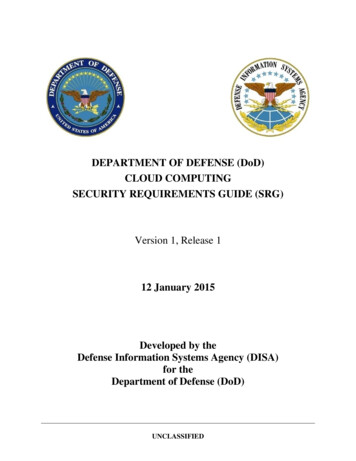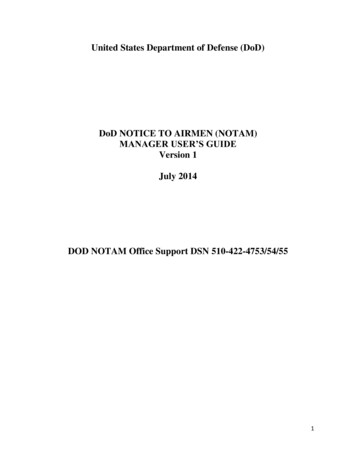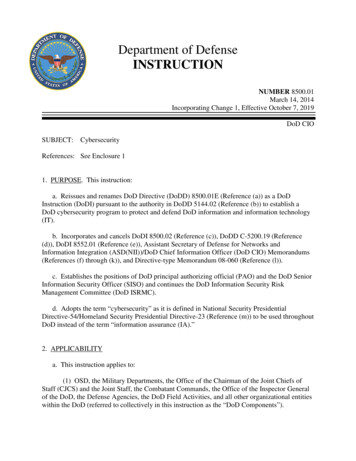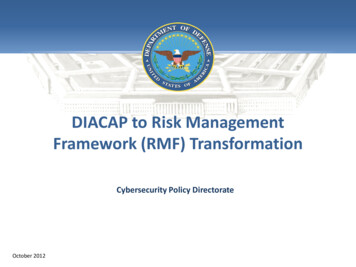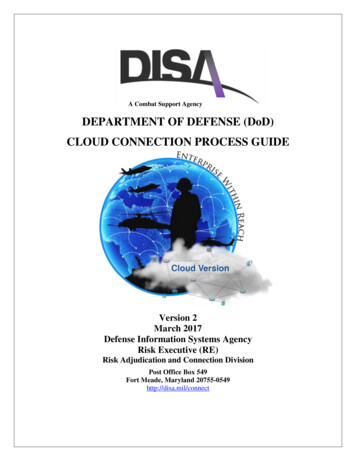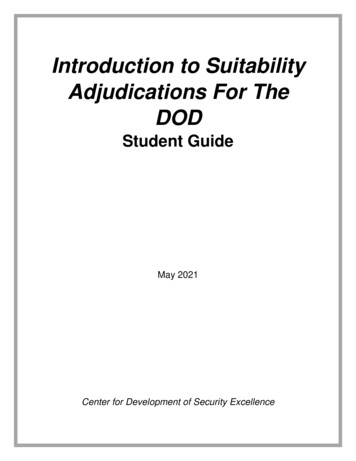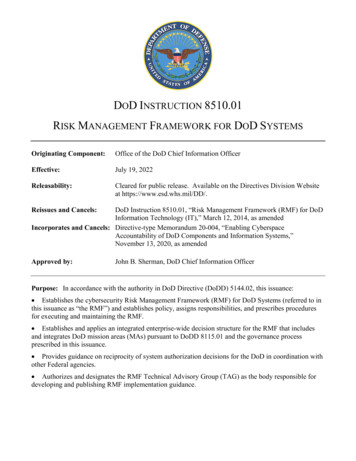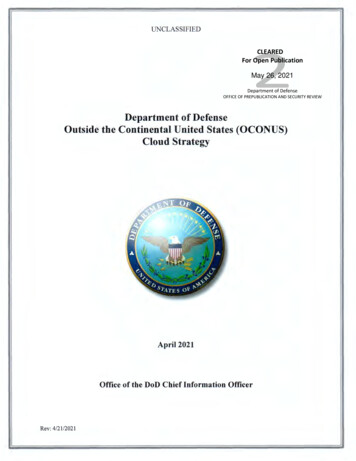
Transcription
UNCLASSIFIEDCLEAREDFor Open PublicationMay 26, 2021Department of DefenseOFFICE OF PREPUBLICATION AND SECURITY REVIEWDepartment of DefenseOutside the Continental United States (OCONUS)Cloud StrategyApril 2021Office of the DoD Chief Information OfficerRev: 4/2 1/2021
UNCLASSIFIEDForeword"The reemergence of long-term strategic competition, rapid dispersion of technologies,and new concepts of warfare and competition that span the entire spectrum of conflict require aJoint Force structured to match this reality.To succeed in the emerging security environment, our Department and Joint Force willhave to out-think, out-maneuver, out-partner, and out-innovate revisionist powers, rogueregimes, terrorists, and other threat actors.To support these missions, the Joint Force must gain and maintain informationsuperiority . "2018 National Defense Strategy"Cloud devices employed by warfighters at the tactical edge . . will ensure warfightersare retaining data, feeding it back into models, and fighting with the most recent algorithms.Doing this in a secure environment will be a force multiplier and directly support the primarygoal of the cloud environment: information superiority. "2018 DoD Cloud StrategyThe Department of Defense (DoD) Outside the Continental United States (OCONUS)Cloud Strategy establishes the vision and goals for enabling a dominant all-domain advantagethrough cloud innovation at the tactical edge. It identifies areas requiring modernization torealize the potential of cloud computing in direct support of the warfighter, specifically:security, redundancy, reliability, and availability. It focuses on extending ContinentalUnited States (CONUS) cloud computing to the globally deployed elements of theDepartment to include the African, European, Indo-Pacific, Middle Eastern, and SouthAmerican Theaters to the tactical edge. The outcomes of the strategy align with and furtherthe priorities of the National Defense Strategy and DoD Digital Modernization Strategy.DoD is committed to providing cloud computing to the warfighter at the tactical edge.These resources are fundamental to enabling a Joint Force capable of quickly and decisivelymobilizing air, land, sea, space, and cyberspace capabilities in response to adversaries threateningUnited States (U.S.) and Allied National Security priorities and objectives.Acting, Chief Information Officer of theDepartment of Defense11
UNCLASSIFIEDTable of ContentsForeword . ii1.Operational Challenges at the Tactical Edge . 12.DoD OCONUS Cloud Vision . 13.Goals and Objectives . 23 .1.Goal # 1: Provide Robust and Resilient Connectivity to the Tactical Edge . 2Objective 1: Modernize in Theater Communications Infrastructure . 3Objective 2: Secure Cloud Connections Through OCONUS Cloud Access Points . 3Objective 3: Leverage State-Of-The-Art Technologies to Connect D-DIL Environments . 3Objective 4: Enable Access to Information From Multiple Devices and Data Sources . 33.2.Goal #2: Provide Computing Power that Enables Forces at the Tactical Edge . 3Objective 1: Deploy OCONUS Cloud Computing Under an Enterprise Construct. . 4Objective 2: Optimize Data Center Infrastructure for Resilient Access to Data and Services.4Objective 3: Provide Ability to Traverse Cloud Environments for Persistent Data Access . 4Objective 4: Protect Data in the Cloud While Enabling Information Sharing . 53.3.Goal #3: Deploy Talent at the Point ofNeed . 5Objective 1: Establish OCONUS Rotations for Technical Talent. . 5Objective 2: Institute Training for OCONUS Users to Maximize Use of Cloud Resources . 5Objective 3: Deploy Research Talent to Better Address OCONUS Challenges . 5OCONUS Unique Considerations . 64.5.4.1.Host Nations . 64.2.Real Estate, Space, and Power . 64.3.D-DIL Environments . 64.4.Data Sovereignty in the Mission Partner Environment (MPE) . 6Next Steps . 7111
UNCLASSIFIED1. Operational Challenges at the Tactical EdgeThe OCONUS environment presents unique challenges in meeting warfighter and missionowner requirements based on geographic location, mission set, partnerships, and operatingconditions.Every warfighting asset, including the warfighters themselves, is a potential producer and/orconsumer of information. This information must be accessed, analyzed, and distributed to enabledata-driven decisions at the speed of relevance. Operating effectively in theater requires persistentaccess to data sources and producers within a transient, dynamic, and often contested environment.The most significant challenge OCONUS users face is access and sharing information in Denied,Disconnected, Intermittent, or Limited (D-DIL) environments. This challenge is furthercomplicated by the reliance on reach-back to CONUS to access data repositories, analyticaltechnologies, and artificial intelligence/machine learning (Al/ML) advancements for theproduction of more precise, impactful information and thereby, advancing more informed decisionmaking.Hostile cyber actors will continue using technical and non-technical means to attempt to defeatthe cloud's cybersecurity safeguards, access data and information, and interfere with or disablesystems. An adversary's capabilities will evolve over time to become more lethal and elusive. It isessential that every DoD cloud employ world-class cybersecurity capabilities to continuouslyovermatch the threat.Valuable data collected and stored locally in theater to support mobile mission sets are oftendisconnected from broader CONUS-based data repositories, impeding the ability ofgeographically separated forces to process and correlate perishable information. The jointbattlespace requires innovative approaches to cloud resources to ensure data is available at thepoint of need.At the tactical edge, use of cloud computing requires secure information sharing throughhuman-to-human collaboration, human-to-machine teaming, and machine-to-machine dataexchange while remaining, secure, redundant and available to the warfighter.2. DoD OCONUS Cloud VisionEnable dominant all-domain advantage through cloud innovation and resilience.Cloud computing can help solve today's national defense challenges, but its true potential is tosolve tomorrow's challenges. These challenges will require a Joint Force capable of quickly anddecisively maneuvering and mobilizing air, land, sea, space, and cyber capabilities in response toadversaries threatening U.S. and Allied National Security priorities and objectives. Collaborationacross these domains, increasingly enabled by high-tech, software-driven solutions, must occur atthe global point of need, at the tactical edge, and at the fight. These collaborative efforts can'thappen without a modem and resilient OCONUS infrastructure, of which cloud computing andzero trust principles are fundamental.The DoD OCONUS Cloud Strategy establishes goals and objectives specifically focused ondelivering cloud innovation forward to the tactical edge with the intent of achieving the followingoutcomes:1
UNCLASSIFIED An All-Domain Advantage: Modem warfare will require a force that can quickly utilizeall appropriate assets in a decisive and concerted response. As such, operational strategiesand plans will leverage information from strategic-level commands; sensors across air,land, sea, and space; cyber threat and vulnerability sources; and logistics and resourcesystems. Additionally, executing these strategies and plans will require cutting-edgeanalytics of critical information to ensure conditions remain appropriate and opportunitiesstill exist. Cloud computing must enable this data aggregation by providing compute andstore capacity with the global reach and innovative services to realize data potential througha data-centric design. Information Advantage for the Wa,fighter: The combination of access to a greaterbreadth of data and the growing use of wearable digital components, Internet of militarythings (IoMT), and unmanned systems (UMS) enable warfighters to transform cloudresources into an operational and tactical advantage. AI/ML must analyze and process largedata files to inform the warfighter's decision. This will require computing capacity andinnovative services at the tactical edge. Through mobile data centers and edge computingtechnologies, cloud computing must support these processing power requirements for ourwarfighters when and where needed. Continued Innovation of Capabilities: DoD's weapon systems and mission capabilitieswill be increasingly influenced by and dependent on software. Abilities such as rapidlyimplementing or tuning AI/ML algorithms, immediately responding to cyber threats, anddeploying new software to fighter aircraft in flight will be critical. Accordingly, fightingand winning on the next battlefield will be dependent on the Department's proficiency inthe rapid acquisition, integration, testing, and deployment of new software and cloudcomputing capabilities. Cloud computing, applying continuous delivery of services models(e.g.,Development,Security,andOperations (DevSecOps),ContinuousIntegration/Continuous Delivery or Continuous Integration/Continuous Deployment(CI/CD)), and Infrastructure as Code (IaC)) must enable continued innovation of digitally driven capabilities while in the fight.3. Goals and ObjectivesDelivering cloud innovation to the tactical edge requires modernization within all layers of theinfrastructure. This modernization must meet the needs of a range of user-profiles in theater, fromthe warfighter operating outside the wire to the mission planner or I. T. administrator operatingwithin an established base perimeter or U.S.-led humanitarian efforts. The following goals arespecific for OCONUS modernization, taking into account the range of user-profiles and integrationwith enterprise cloud resources.3.1. Goal #I: Provide Robust and Resilient Connectivity to the Tactical EdgeWarfighters at the tactical edge must inform and be informed by strategic-level planning. Theneed to receive the most current information by leaders OCONUS or to provide the latestinformation to leaders in CONUS is crucial in operational planning efforts and in achieving adecision-making advantage. The warfighter often operates in environments with limitedbandwidth, sporadic connectivity, or no connection to the Internet due to OCONUS infrastructureand/or physical limitations. This goal requires the ability to quickly and securely receive and send2
UNCLASSIFIEDinformation at all classification levels from both well-connected regions and D-DIL environments.DoD requires OCONUS transport and network capabilities that allow for robust and resilientcommunications. The OCONUS infrastructure must be capable of forward deploying enough datato support a disconnected user or a user at the tactical edge, and once communications allow,seamlessly re-integrating those users and their data into the broader enterprise, while not revealingtheir location to adversary forces.Objective 1: Modernize in Theater Communications Infrastructure.As the number of connected devices and sensors grows exponentially, so does the need forincreased communications connectivity. The communications infrastructure (e.g., data transportoptical fiber, data relay towers, and ground stations) must support an increasingly complex dataarchitecture to connect data consumers and producers to the digital services they require as wellas to each other. This transport must be fast, secure, and resilient, aiming for reduced latency,redundancy, and minimal degradation to data quality.Objective 2: Secure Cloud Connections Through OCONUS Cloud Access Points.Boundary Cloud Access Points (BCAP) establish a protected boundary between the DefenseInformation Systems Network (DISN) and an approved commercial service provider. Voice CloudAccess Points (VCAP) interconnect current DoD Plain Old Telephone System/Public SwitchedTelephone Networks (POTS/PTSN) with VoIP/Cloud Phone systems contained withincommercial service provider collaboration and office productivity tool suites. These cloud accesspoints must be appropriately implemented and deployed OCONUS at all classification levels atcommercial Points of Presenc·e (PoP) to ensure secure connections between cloud providers andDoD networks while maintaining the high-speed delivery of data.Objective 3: Leverage State-Of-The-Art Technologies to Connect D-DIL Environments.Users at the tactical edge routinely operate with limited bandwidth, limited Size Weight andPower (SWaP), and with a need to minimize the likelihood of detection. Connectivity to remotelocations requires additional communications capabilities, such as satellite or wirelesscommunications provided by local telecommunications companies. New technologies forconnecting data flows to the tactical edge, including capabilities like 5G, Software-Defined WideArea Networking (SDWAN), and industry pursuits of satellite constellations for the Interneteverywhere, are also underway, presenting new opportunities for connecting to the tactical edge.These technologies must be explored and integrated to provide warfighters with consistent andsecure connectivity anywhere, anytime.Objective 4: Enable Access to Information From Multiple Devices and Data Sources.Operational conditions may not always permit the use of desktops/workstations to access data.Mobile devices, laptops, and other tactical communications equipment (e.g., transit cases,antennas) require interface with cloud resources to ingest or disseminate mission data.3.2.Goal #2: Provide Computing Power that Enables Forces at the Tactical EdgeOCONUS users require on-demand access to mission-critical information, applications, andservices at the tactical edge for command and control and information sharing with higherheadquarters to establish a common operational picture of the battlefield. Additionally, as weaponsystems and mission capabilities become more digitally dependent, updating software quickly,such as refining AI/ML algorithms, must be done locally to optimize the capability. Today,3
UNCLASSIFIEDavailable and evolving enterprise digital solutions are often CONUS-based. For OCONUS users,reaching back to CONUS-based solutions reduces mission effectiveness in theater (e.g., addedlatency, lack of resilient data transport and access). DoD requires innovative, secure, reliable, andredundant cloud computing at the tactical edge with reach back to CONUS to empower the JointForce and achieve an operational advantage.Objective 1: Deploy OCONUS Cloud Computing Under an Enterprise Construct.The deployment of OCONUS cloud computing must be managed as an enterprise to ensuremore efficient technology approvals. This is particularly relevant for security accreditation andparity of cloud services between the enterprise and OCONUS. Doing so provides more efficientuse of cloud resources based on mission needs across the region and greater efficiencies in fieldingproven cloud capabilities. Data needs to be processed close to its source and staged as close to thewarfighter as possible to enable data-driven decisions. The warfighter requires the ability to applyanalytical tools or to rapidly stand up temporary Task Force collaboration environments regardlessof geographic location. OCONUS users must have access to deployable cloud computing, high performance computing, and edge computing capabilities as they become available. This includesinnovative cloud services that enable agile software development, robust collaboration, andpowerful analytics such as Al/ML. Individually approving and implementing these capabilities atthe point of need results in duplicative efforts and sub-optimal use of capacity. Management on anenterprise-level will also require the facilitation of data flows between domains of varying levelsof classification while ensuring appropriate accreditation policies and procedures are maintained.This will be both an information assurance and an information security effort at the enterprise levelto ensure that the warfighter maintains the advantage at the tactical edge.Objective 2: Optimize Data Center Infrastructure for Resilient Access to Data andServices.DoD recognizes that not all systems can reside in a cloud environment. There is a continuedneed for data center infrastructure, which must be optimized in alignment with cloud resources toaccount for reliability and availability (e.g., continued operations, data replication). Distributedmobile cloud data centers and their integration with DoD data centers must allow for a distributedcloud model for broader availability of cloud capabilities, including automated failover of storeddata in times of crisis and operational disruptions (e.g., cyber-attacks, infrastructure degradations,or outages). DoD's data center infrastructure must appropriately integrate with cloud resources toallow for a seamless and resilient OCONUS user experience.Objective 3: Provide Ability to Traverse Cloud Environments for Persistent DataAccess.A warfighter carrying out a mission requires persistent access to information hosted by variouscloud providers, in different environments, and at multiple classification levels. This informationecosystem must include data to and from various tactical devices and mission partner environmentsthat enable information sharing with coalition partners. Mission owner and warfighter access toinformation must not be tethered to a specific cloud solution or data center. They must be availableregardless of geographical location or coalition partnership. This requires the automatedsynchronization of data across the cloud environment to include ruggedized tactical devices whenavailable.4
UNCLASSIFIEDObjective 4: Protect Data in the Cloud While Enabling Information Sharing.OCONUS mission success relies heavily on the Department's relationships with missionpartners. The ability to share information in a protected environment with non-DoD users iscritical. OCONUS cybersecurity solutions must incorporate zero trust principles to ensureprotections closer to the data and include robust identity, credential, and access management(ICAM) to drive out anonymity and enable the secure sharing of information. Zero trust solutionsmust control user activity within emerging cloud-enabled cyber terrain. In coordination with theCyber National Mission Force, they must also facilitate the deterrence, disruption, or the defeat ofhostile red actors in cyberspace. DoD data hosting environments and services require the samecybersecurity protections and defenses when operating in and traversing OCONUS cloud-hostedenvironments when they are operating CONUS.Additionally, an OCONUS Cloud Defensive Cyber Operations Concept of Operations (DCOCONOPS) must be developed before technology acquisition and implementation to guide theseactivities. While requirements may vary from theater to theater, cybersecurity measures must beimplemented to support the warfighter's confidentiality, integrity, and availability of mission data.The measures should be tested against realistic cyber threat representations on a recurring basis toensure effectiveness.3.3.Goal #3: Deploy Talent at the Point of NeedEffective OCONUS cloud capabilities require an understanding of the OCONUS missionenvironment. In addition, they require an influx of personnel with novel aptitudes, expertise, andcredentials. DoD must begin to deploy and grow OCONUS talent (Military, Civilians, andContractors) to maximize the use of new technologies and inform the research and developmentof future capabilities.Objective 1: Establish OCONUS Rotations for Technical Talent.Cloud computing, and the solutions it enables, require new skillsets at the tactical edge. Newknowledge areas not typically seen may include software development and AI/ML. DoD must seekand rotate technical talent OCONUS to maximize the benefits of technology to drive a greatercompetitive advantage. Rotations also provide direct mission experience for improveddevelopment of OCONUS solutions.Objective 2: Institute Training for OCONUS Users to Maximize Use of CloudResources.Tomorrow's warfighter must be equipped with the technical skillsets to operate and maintainsoftware-driven mission capabilities at the tactical edge. DoD must train OCONUS users toeffectively employ cloud services for faster aggregation and analysis of data, delivery of software,and response to cybersecurity threats. Therefore, robust warfighter training must include cloudcomputing to fully realize technical advantage, information superiority, and global Joint Forcemilitary advantage.Objective 3: Deploy Research Talent to Better Address OCONUS Challenges.DoD must continue to improve warfighting and mission capabilities, staying ahead ofadversaries investing heavily in new technologies. As such, research and development efforts mustbe informed by OCONUS challenges to ensure warfighting relevance. Deploying research teams5
UNCLASSIFIEDOCONUS provides the on-the-ground experience needed to develop mission solutions that makea difference.4. OCONUS Unique ConsiderationsOCONUS infrastructure modernization efforts have unique considerations not required whenimplementing infrastructure in CONUS.4.1.Host NationsAny DoD data center established in a host nation must be negotiated and agreed upon by boththe U.S. Government and the host nation. Current cloud and data control laws allow the host nationto have full-scale access to cloud computing and data centers hosted on a country's soil, such asthe European Union's General Data Protection Regulation (GDPR). In contrast, DoD requires fullcontrol and access to cloud computing and data centers. Given the challenges with meeting hostnation data control requirements, cloud service providers must make a significant investment tosupport OCONUS locations.4.2.Real Estate, Space, and PowerOCONUS space and power is limited. This limitation impacts the number of viable U.S. controlled military locations for typical data center cloud infrastructure. Successfulimplementation of a tactical edge cloud will require the adoption of new and alternativecommercial solutions that provide the necessary computational power at lower SWaP. Bringingcloud computing to the tactical edge will require resources, including resources such as space,power, and bandwidth provided by OCONUS base, camp, post, and stations to ensure reliable andsecure connectivity and access at the point of need.4.3.Denied, Disconnected, Intermittent, or Limited (D-DIL) EnvironmentsThe warfighter, service support, and U.S led humanitarian efforts often operate inenvironments with limited bandwidth, sporadic connectivity, or no connection to the Internet dueto poor OCONUS infrastructure and/or physical limitations. The OCONUS infrastructure must becapable of forward deploying enough data to support a disconnected user or a user at the tacticaledge and, once communications allow, seamlessly re-integrating those users and their data into thebroader enterprise while not broadcasting their location to adversary forces. Future edge devicesconnecting to the tactical cloud should be designed and operated with the goal of preservingoperational effectiveness though different degrees of connectivity to the tactical cloud, includingauto-synchronization with cloud capabilities, once re-connected.4.4. Data Sovereignty in the Mission Partner Environment (MPE)The requirement to integrate fully with the host nation and MPE is paramount to missionsuccess. Successful operations within the MPE are dependent on ensuring the correct informationgets to the authorized personnel at the speed of relevance to enable data-driven decision-making.This requires coordination with U.S./DoD Records and Security Officers to ensure that the U.S.maintains control and sovereignty over U.S. data collected, generated, or shared in the OCONUSenvironment. Special considerations must be taken into account for the host nation's datalocalization laws, which may require cloud service provider compliance to support DoDOCONUS.6
UNCLASSIFIED5. Next StepsDoD must take action to execute this strategy to ensure cloud capabilities are delivered to thewarfighter. The Department will convene the DoD Components responsible for the planning,funding, and execution activities that will enable a dominant all-domain advantage throughcloud innovation and resilience. DoD CIO and the Joint Chiefs of Staff (J6) will co-lead thedevelopment of an enterprise OCONUS cloud architecture that will integrate the components ofthis strategy and inform OCONUS investments and technical implementation decisions. Based onthe architecture and strategy, DoD CIO and the J6 will co-lead the development of animplementation plan to ensure coordinated execution of OCONUS modernization activities,including measurements of each objective's effectiveness and prioritization of each goal andobjective to ensure the warfighter's needs are met at the tactical edge. Effective implementation iscritical to maintaining the DoD's technical advantage and delivering information superiority.7
exchange while remaining, secure, redundant and available to the warfighter. 2. DoD OCONUS Cloud Vision . Enable dominant all-domain advantage through cloud innovation and resilience. Cloud computing can help solve today's national defense challenges, but its true potential is to solve tomorrow's challenges. These challenges will require a .


